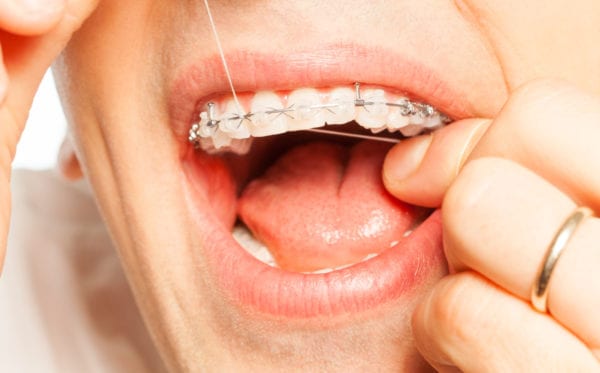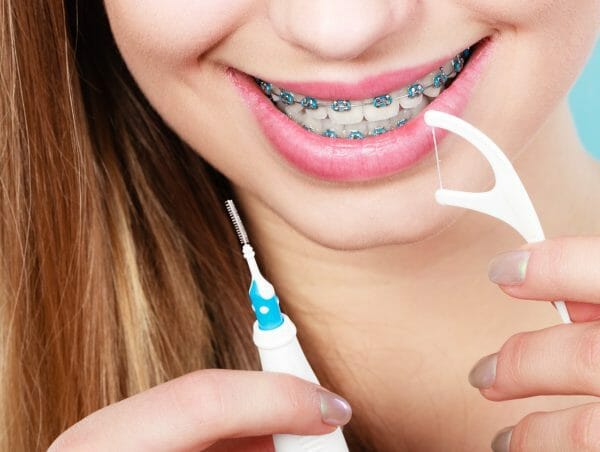How to Floss with Braces
Flossing with braces can be more challenging than flossing without braces, especially for younger children. Most orthodontists who treat young kids recommend that parents help them with flossing until they can do it well on their own (typically around 10 years old). Even teenagers may need to learn new flossing techniques and get accustomed to new tools once they begin wearing braces.
This article discusses some of the different tools and techniques that can be used to floss with braces. Parents may want to try a few until they find one that works best for their child or teen. The tools and techniques mentioned in this article can be used for all types of braces, including Damon braces, clear ceramic braces, and metal braces.
In addition, the doctors and staff at Burke & Redford Orthodontists can help demonstrate proper flossing techniques while wearing braces.

Floss Picks for Braces
Floss picks can be easier to use than dental floss, especially for younger children. This is because the pick holds the floss. Floss picks for braces include brands such Platypus Orthodontic Flossers and Plackers Orthopicks.
Ortho floss picks do not require threading and are made to fit under the archwires, between teeth, and up toward the gums. Using these floss picks allow teens and children to floss their entire mouth in two minutes or less.
The downside of floss picks is that each pick can only be used once.
How to Use Floss Picks for Braces
- Slide the thin arm between the teeth and the archwire.
- Guide the floss between the teeth.
- Gently slide floss into the space between the gum and tooth—rubbing the floss gently up and down. Make sure to keep the floss pressed against the tooth.
Check YouTube for videos demonstrating how to properly use orthodontic floss picks or ask for help from one of our staff members.

Dental Floss for Braces
When choosing a dental floss for braces, one option is Oral-B Super Floss. Super Floss is like regular dental floss except the threads are pre-cut. One end is stiffened so it can be guided under the archwire for cleaning. The product also has spongy floss to clean around appliances and regular floss to help remove plaque under the gumline. This type of floss may be easier to use for kids with braces.
If using regular dental floss with braces, use waxed floss because it is thicker than unwaxed floss and less likely to get caught on brackets. Keep in mind that the flossing process will take longer than usual when wearing braces.
Using regular dental floss alone with braces can be time-consuming and requires a certain amount of dexterity, which is why it is the most difficult option for children’s braces. Even teens may get frustrated with the process and the required time. So, using another tool or technique mentioned in this article can be helpful for kid’s orthodontics.
How To Use Dental Floss for Braces
- Thoroughly brush teeth.
- Get a piece of floss that is approximately 12 to 18 inches long.
- Thread the floss behind the archwire.
- Wrap the ends of the floss around the index fingers.
- Move the floss between teeth in the shape of a “C.” Make sure to move the floss up and down to clean the vertical sides of each tooth.
- After completing one tooth, carefully remove the floss from behind the wire.
- Repeat with each tooth.
Floss Threader for Braces
A floss threader makes it easier to floss with braces. A floss threader is like a needle and thread—with the floss threader being the needle and the floss being the thread. The floss threader makes it easier to get the floss beneath the archwire. Waxed floss is the best option to use with a floss threader.
One benefit of using a floss threader for braces is that they are reusable and inexpensive. However, the process can be time consuming and may be difficult for young children. Some brand names that make floss threaders include Oral-B, GUM, and DenTek.
How To Use a Floss Threader for Braces
- Put a piece of floss through the floss threader.
- Move the threader under the archwire of the braces and pull the floss through.
- Once the floss is under the archwire, follow the instructions for normal flossing listed above, repeating the process for each tooth.

Proxy Brushes for Braces
A proxy brush (also known as interdental brushes) is a small brush that makes it easier to get between teeth to remove flood and plaque. These brushes should only be used with water—not toothpaste. Some brand names include GUM Proxabrush or DenTek Slim Brush Interdental Cleaners.
Proxy brushes can be reused for a few days before needing to be replaced. Be sure to rinse off the brush between each use.
How To Use A Proxy Brush with Braces
- Insert the proxy brush under the archwire and between the teeth.
- Scrub to clean.
- Repeat with each tooth.
Water Flosser for Braces
For children and teens, a water flosser can be a very useful tool to flush food, plaque, and debris away from braces and from underneath expander devices. A water flosser sprays a steady stream of water and is able reach difficult to access parts of the mouth. A water flosser is a good option for kids because it does not require too much manual dexterity. It does not replace actual floss, however, and should be thought of as an adjunctive to brushing and flossing.
One downside to water flossers is that they are pricier than other options discussed in this article. A popular brand of water flosser is the Waterpik. A countertop unit may cost up to $70 while portable units may cost as little as $30. The good news is that the unit will last for a long time and can be used for flossing once the braces come off.
Although a water flosser may be a little messy as a child gets used to using it, a little bit of practice will help. One feature to look for is an easy on/off switch on the handle that allows the user to easily stop the flow of water.

How to Use a Water Flosser with Braces
- Fill the water reservoir with water. (Mouthwash can be added to the water but is not required.)
- Put the tip on the water flosser. (Some models come with an orthodontic tip.)
- Press the start button to test the flow of water and then turn it off.
- Lean over the sink and place the tip of the flosser in the mouth.
- Turn on the water flosser—keeping lips closed to prevent water from splashing out of the mouth. However, it is important to let the water drain out of the mouth when flossing.
- Direct the water stream between each tooth and across the gumline.
- Continue until the entire mouth has been cleaned.
Best Floss for Braces
The best floss for braces is one that the patient will use every day. If flossing becomes too time-consuming or difficult, patients may stop flossing altogether. Therefore, orthodontists recommend trying different tools and techniques until a child or teen is comfortable while flossing with braces.
For younger patients who lack the manual dexterity or patience for using traditional flossing techniques, a floss pick, proxy brush, or water flosser may be the best options. Learn about the benefits of having straight teeth.